Imagine this: You’re in front of your computer, trying to write an awesome piece of content for your target audience, but you’re having a hard time finding the right angle.
Sounds familiar?
A problem many marketers (including myself) face when writing content is that they don’t know who they’re writing for (read: they haven’t considered their buyer personas)
You might know that you’re writing for fellow marketers or tech-savvy entrepreneurs, but do you really know who they are and what they need?
Having a profound understanding of your target audience is critical for any business looking to drive content creation, product development, sales and anything else that has to do with customer acquisition and retention.
Most important of these is email marketing.
I won’t tell you how effective email marketing is because you already know.
I will, on the other hand, tell you how to align your email marketing to unique buyer personas to increase sales and create strong, lifelong customer relationships.
But before we get into it:

What are Buyer Personas?
Before we take off and start creating buyer personas, let’s start with a brief definition of the concept.
Marketing strategist, Ardath Albee, proposes the following definition:
A marketing persona is a composite sketch of a key segment of your audience. For content marketing purposes, you need personas to help you deliver content that will be most relevant and useful to your audience.
While the definition of a buyer persona is relatively straightforward, the creation of buyer personas can be challenging.
How do you figure out exactly who your target audience is, and what they want?
How to Find and Create Buyer Personas
There are two types of data you should be looking at when creating your buyer personas:
Demographic data and psychographic data.
Let’s take a closer look at each one.
1. Demographics
Finding demographic data on your customers is relatively easy because the information is easily accessible and can be obtained without communicating with your audience.
This data could be age, gender, location, employment status, and more.
While there are many ways to research buyer personas based on demographic data, my favorites are through Google Analytics (GA), customer service, and your contact database.
i. Google Analytics
You’re probably already familiar with GA, so I won’t go into detail explaining where to find all the relevant data.
The idea here is to get a quick overview of the basic demographic data of your audience, in this case—your sessions.
Here you can find an overview of your audience’s demographics such as age, gender, and location, which will provide you with a foundation for your buyer personas.
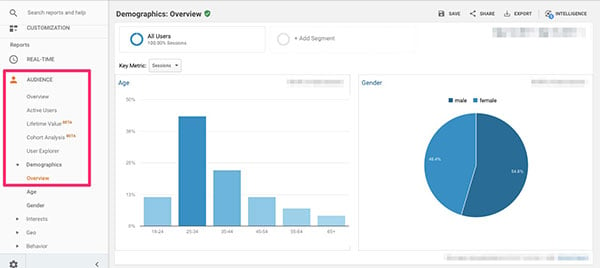
I say buyer personas in plural because you’ll unlikely create one buyer persona that fits your entire target audience—no matter what your product is.
So, create multiple buyer personas that you can target with personalized content, rather than target one buyer persona with generic content.
ii. Customer Service
Your customer service department is sitting on a pot of gold when it comes to customer insights.
They’re the people who talk to your customers every day and learn about their problems and challenges.
What generalizations can be made about your customers through the interaction they have with your team? Are there any recurring trends to be discovered?
These are the questions your customer service team should always keep in mind when interacting with customers and prospects.
iii. Contact Database
Your contact database—or your contact management system (CRM)—is a great place to discover demographic data about your leads and customers.
You might be interested in knowing what type of business they’re in, or what actions they’ve taken with your business.
Dive into the data you already have on your contacts, and search for trends and see if there are any generalizations to be made.
You’ll be surprised how much you can learn by going through existing data, and how you can use this data to create or refine your buyer personas.
2. Psychographics
Psychographic data can be harder to obtain than demographic data, but it also has more value for your business.
This type of data allows you to connect with your audience on a deeper level, and create content that resonates with them.
Psychographic data includes the attitudes, interests, and values of your audience.
Let’s take a look at ways of collecting psychographic data for your buyer personas.
i. Email Replies
The era of no-reply emails is over (or at least it should be).
You should always encourage your audience to respond to your emails, whether it be through direct questioning or a subtle allusion.
Many marketers have begun asking these types of questions in their emails to get to know their audience better.
Here’s an example from Pat Flynn:
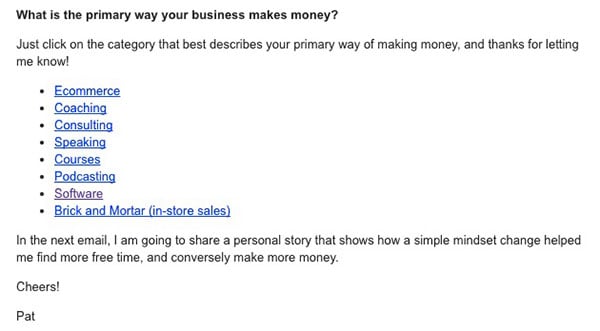
Another example is to ask for feedback when customers churn or potential customers don’t convert into customers.
This is an excerpt from one of the emails:

ii. Reddit
Reddit is a killer resource when it comes to gathering consumer insights.
You can find information on ANYTHING.
By searching for keywords related to your product in subreddits, you can see what’s most important to your audience and what they’re struggling with.
For instance, there’s a popular subreddit called r/askwomen where women ask each other all kinds of questions from career advice to cleaning tips.
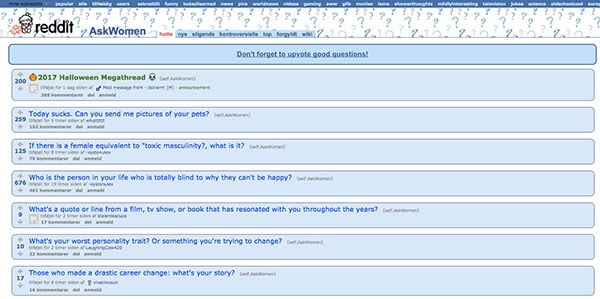
Here’s what I found when searching for “cleaning.”
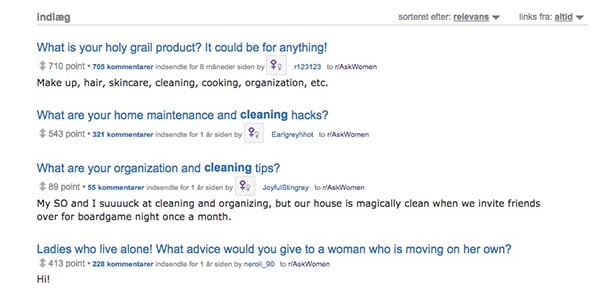
Most of the cleaning posts are requests for cleaning tips and hacks.
As an online store selling cleaning products or cleaning equipment this would be a great topic to address in the content you’re publishing.
Combine this information with your demographic data, and you can create targeted cleaning guides for specific buyer personas based on this data.
iii. Quora
The concept here is similar to that of Reddit.
Quora is the rallying of questions.
You can find a question (and an answer) to pretty much anything on Quora.
Let’s say you run an e-commerce store specializing in running equipment.
You could use Quora to search for specific topics on running and see what comes up.
This is what I found when searching for “marathons”:
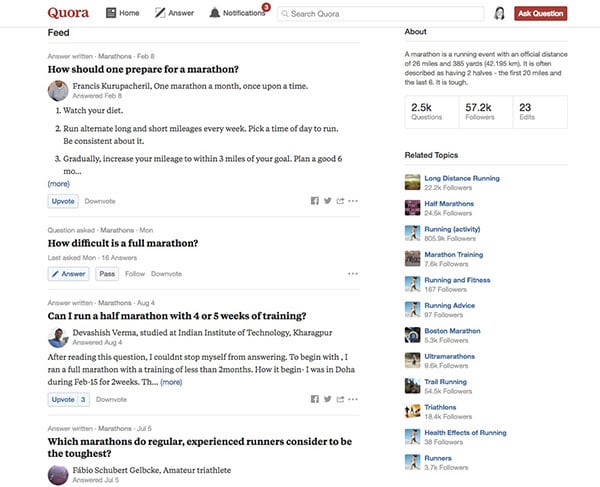
As you can see, a common question related to this topic is how to prepare for a marathon.
If you provide your marathon-enthusiastic buyer persona with information on this, they’ll be much more likely to convert into repeat customers.
When collecting psychographic data you should pay close attention to the exact words people use—you’ll need that when creating targeted content.
Now let’s have a look at how you use this data in practice.
How to Communicate Effectively with Your Target Audience Through Email Marketing
Once you’ve created your buyer personas based on the data you’ve collected, it’s time to customize your email content to these personas.
I. Use Words Your Buyer Persona Will Identify With
It’s no longer enough to let your audience know you understand them and can help them solve their problems.
You need to communicate with them in the language they use if you want to connect with them.
And by language, I don’t mean English, Spanish, or Chinese. No, I mean the type of language and the words they use.
Dollar Shave Club, for example, differentiate themselves from their competitors by speaking like their customers:
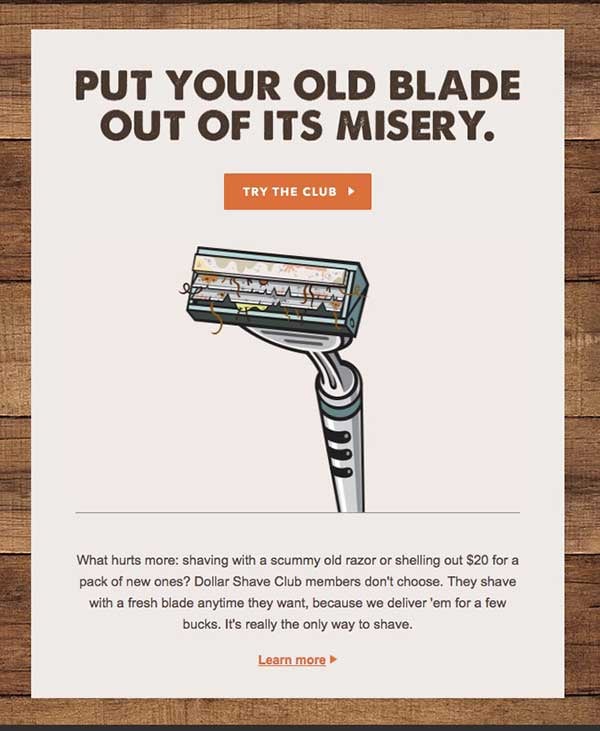
Another example is Barkbox, who connect with their audience through their love of dogs:
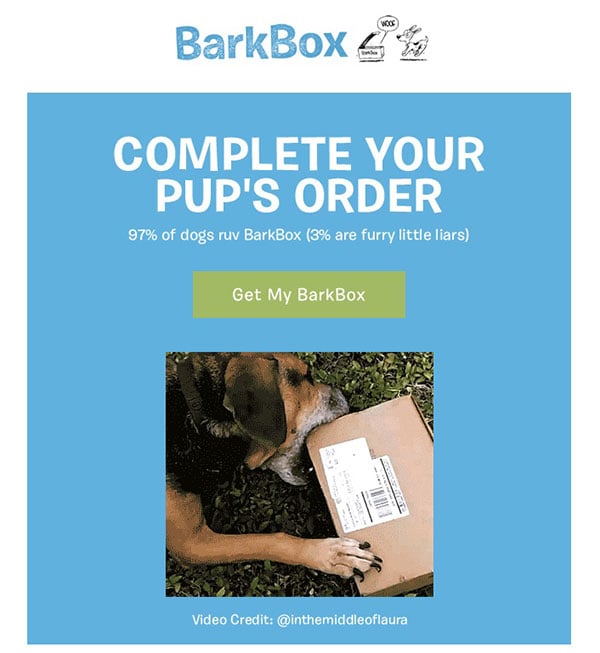
By saying “Complete your pup’s order” and not your own order, BarkBox puts focus on the dogs and humanizes them, which resonates with their buyer persona.
Every aspect of your email from the subject line all the way to the PS needs to be consistent with your brand’s voice, and how you want to communicate with your specific buyer personas.
Here’s another example from Barkbox:

Once again, they create and use words that they know their personas will resonate with. Had this subject line been from an e-commerce selling electronics, it wouldn’t have made sense.
ii. Be Unique
I tend to use this subheading quite a lot in my writing, and for a good reason.
It’s true!
Being unique is the best way to stand out in your reader’s overcrowded inbox.
But with more and more businesses adopting a unique angle to email marketing, it’s difficult to figure out how your marketing will stand out.
One of my favorite authors on this subject is André Chaperon.
André writes email sequences like you would write a TV series like “Lost.” He refers to this as a “soap opera sequence.”
In every email, he asks big open-ended questions that you don’t know the answer to. And by email seven you’ll have 40 unanswered questions, opening every email expecting the answers—sometimes you do, and sometimes you don’t.
With this tactic, you can make your open rates go up for every email you sent. Pretty amazing, right?
The key to a successful soap opera sequence is sending:
- the right email…
- to the right person…
- at the right time
It’s all about relevance.
“But Rikke, you just said it was all about being unique?”
Yes, I did.
Let me explain: If your emails are highly relevant to the specific people you’re sending them to, you’re already unique because most marketers aren’t segmenting as well as they should be.
You can read much more about soap opera sequences from André Chaperon in this article.
iii. Use The Right Images
According to 3M, we process images 60,000 times faster than text.
Further, 93% of consumers consider visual appearance to be the key deciding factor in a purchasing decision.
This information alone would convince most marketers to include images in their email campaigns.
But you can’t just include images and expect your conversion rates to increase.
If you’re using images in your email campaigns, you have to include the right images.
Once again, it comes down to relevance.
Does your buyer personas respond well to images, and if so, what images?
Here’s an example from Topos Designs:
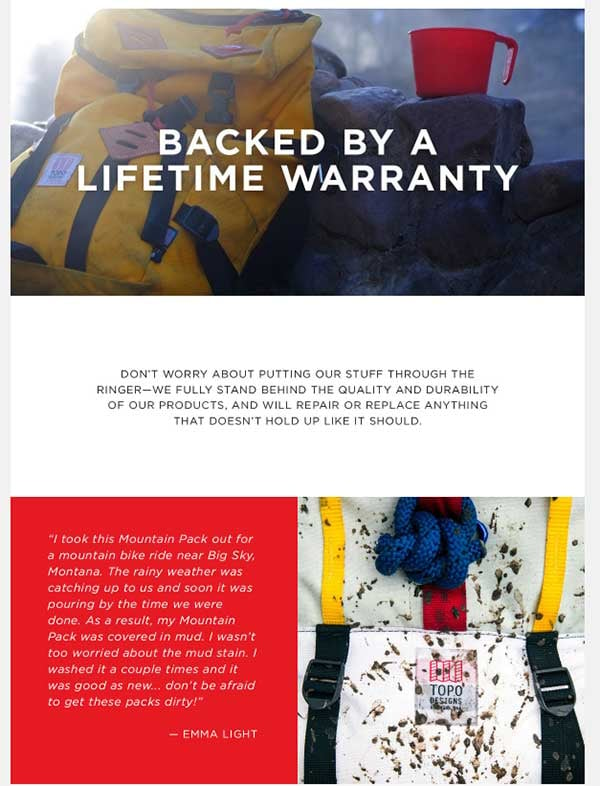
They know their buyer persona is an active outdoors person (among other things), and by including an image of a product in use and a strong testimonial they address the pain points or concerns, their audience might have about the durability and cleaning of the product.
If you include images in your email campaigns, make sure they’re there for a reason. Don’t just add them because they look good.
Images are just like words—they need to be relevant and support the story. Otherwise, they shouldn’t be there at all.

Conclusion
Creating targeted email campaigns for your buyer personas is hard work, but if done right, you’ll not only increase your bottom line but also create stronger relationships with your audience.
When every email is relevant to the receiver, more of your emails will be opened and clicked.



